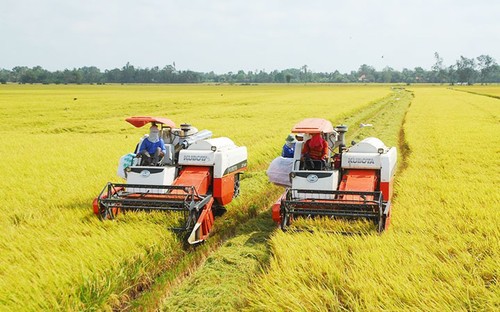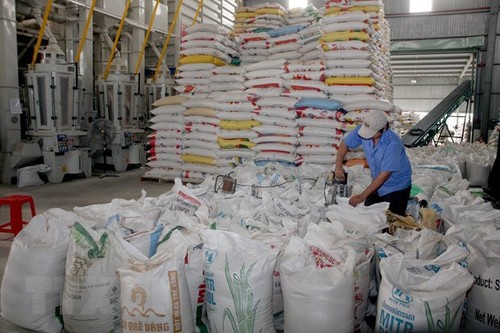|
 In 2020, rice in the Mekong Delta region is sold at high prices In 2020, rice in the Mekong Delta region is sold at high prices
(Photo: baochinhphu.vn)
|
In 2020, Mekong Delta provinces sowed more than 1.5 million hectares of rice, with an average productivity of 6 million tons per hectare and an annual yield of more than 24 million tons, 10 million tons of it expected from the 2020-2021 winter-spring rice crop.
Despite drought and saltwater intrusion, the region’s rice productivity and prices were relatively high. Farmers profits were 30 to 40% or even more, depending on the locality.
Vo Minh Luan, head of the Agriculture and Rural Development Section of Chau Thanh district in Soc Trang province, said, “High prices are one advantage for farmers, especially for new rice varieties like the OM18, OM5451, and ST types. The profits earned from this year’s summer-autumn crop were higher than last year. On average, farmers in Chau Thanh earned between 693 and 779 USD per ha, at least 43 USD per ha more than last year.”
 Rice processing for exports (Photo: VNA) Rice processing for exports (Photo: VNA) |
Rice companies in the region saw a revival of export markets in 2020. Rice exports are expected to reach 6 million tons.
By the end of November, Vietnam had earned nearly 2.9 billion USD from selling abroad more than 5.7 million tons of rice, up 10% in value from last year.
The price of 5% broken rice increased to approximately 520 USD a ton. This is the first time in the past 5 years that Vietnam's rice exports have earned more than 450 USD a ton.
The result is mostly due to improved rice quality. The Vietnam-EU Free Trade Agreement (EVFTA) took effect at the beginning of August, driving Vietnamese rice exporters to increase the quality of rice exported to the lucrative European market.
Nguyen Van Don, Director of the Viet Hung Company in Tien Giang province, said, “This year, domestic exporters have fulfilled the set targets, with selling prices increasing about 10%. Most items were exported to Malaysia, the Philippines, and China. We have prepared export plans for the beginning months of 2021 to these markets and hope to penetrate the EU market when the origin of our products and food hygiene and safety are qualified. To that end, the state, farmers, scientists, and enterprises must work closely with each other.”
Vietnamese rice’s good fortunes are due to three factors:
· First, the Government's agricultural restructuring project has tilted rice cultivation towards better quality rather than greater output.
· Second, Vietnam’s trade agreements like Comprehensive and Progressive Trans-Pacific Partnership (CPTPP) and the EU-Vietnam Free Trade Agreement (EVFTA) have created new markets for its rice.
· Third, although the COVID-19 epidemic has weakened many industries, food demand has not decreased.
Vietnam’s rice exports are expected to remain strong in the first quarter of 2021. Key markets in the Philippines and Africa have already signed contracts for Vietnamese rice.
Vo Quoc Hung, Deputy Director of the Phuoc Dat Company in Tien Giang province, said, “Although the Mekong Delta suffered from severe drought and saltwater intrusion, local farmers still had a bumper crop with high prices. The rice price hike follows a global price increase. This year our export volume was higher than last year, making Vietnam the world’s top rice exporter. I hope the state will allow domestic exporters to export more, but the volume should remain controlled.”